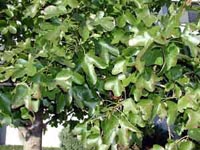Resource Library
Plant of the Week: Sweetgum, Fruitless
The University of Arkansas System Division of Agriculture does not promote, support or recommend plants featured in "Plant of the Week." Please consult your local Extension office for plants suitable for your region.
Plant of the Week
Fruitless Sweetgum
Latin: Liquidambar styraciflua 'Rotundiloba'

Perfection is not only elusive, its attainment is somewhat subjective. Nurserymen have long sought the perfect tree, and about the time they think they have achieved the goal, problems develop.
On its introduction, the fruitless sweetgum (Liquidambar styraciflua ‘Rotundiloba’) seemed like a contender for the title, but we now know it has some warts.
From many perspectives the sweetgum is a good tree for the urban landscape. It grows fast in almost any soil, has good fall color and has few serious insect or disease problems.
But the typical seedling sweetgum has a flaw - it makes sweetgum balls. I’ve tried to convince people that they should look at sweetgum balls as a resource. When I suggest a favorite arts-and-crafts idea, they always counter that the market for glitter-covered sweetgum ball wreaths is dead. Maybe they’re right.
The answer to the problem of sweetgum balls seemed to have been solved when the fruitless sweetgum began to be talked up in the nursery trade in the mid-1980s. The tree has lustrous dark green leaves with the usual five lobes, but on the fruitless form the lobes are rounded, not pointed.
Fall color is variable on this grafted tree. Some years it will shade more towards the yellow and orange range, other years more towards deep burgundy.
Older trees can reach 50 feet tall with an upright form that tends to be more open and erect than the typical sweetgum. Young trees go through a gawky stage that requires some early attention to pruning to develop a good form.
The tree was resurrected from horticultural oblivion by the famous plantsman, J.C. Raulston (1940 - 1996), the founder and namesake of the Raulston Arboretum in Raleigh, N.C. Raulston, a fellow Oklahoman and - as only mothers can explain - a shirt-tail relative of mine, was one of a handful of horticulturists who brought about the new plant craze that swept the world of gardening during the closing years of the 20th century.
J.C. found the tree growing on the campus of William and Mary College in Virginia, apparently a graft from a tree found growing wild in North Carolina in the 30s. The tree was propagated and evaluated for a couple years and then released with the flourish that only J.C. could pull off.
What marked J.C. as different from many plantsmen, is not his willingness to share, but the scope of his sharing. When he discovered a new plant through his extensive travels, he quickly turned the plant into hundreds or thousands of plant starts that were distributed to nurserymen and gardeners throughout the world. Because of his willingness to share and extensive network of contacts, plants could go from rare and unknown to commonplace in a couple years.
Raulston had a restless soul. He traveled extensively around the world and made collecting trips to Europe and Korea. One of his hobbies, visiting every county in the nation (the last I heard he still lacked two in Arkansas), was nearing completion when he was killed in a car accident.
The fruitless sweetgum has not performed quite as well in American landscapes as Raulston predicted. First, it’s not as winter hardy as some northern strains, being cold hardy to only -10 degrees F. This makes it winter hardy throughout Arkansas, but it can winterkill north of St. Louis.
A second problem has been growing a symmetrical tree. Instead of having the cookie-cutter look of trees like Bradford pear, the fruitless sweet gum has a more free form habit. In formal mall plantings where exact duplicates are wanted, this has caused some disappointment.
The fruitless sweetgum should be planted in full sun where it gets some summer moisture. In spring, as new leaves are beginning to form, prune to maintain a straight trunk. Lateral branching will need pruning for the first few years to develop a strong branching system.
By: Gerald Klingaman, retired
Extension Horticulturist - Ornamentals
Extension News - September 20, 2002
The University of Arkansas System Division of Agriculture does not maintain lists of retail outlets where these plants can be purchased. Please check your local nursery or other retail outlets to ask about the availability of these plants for your growing area.